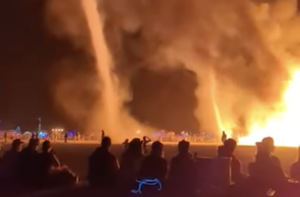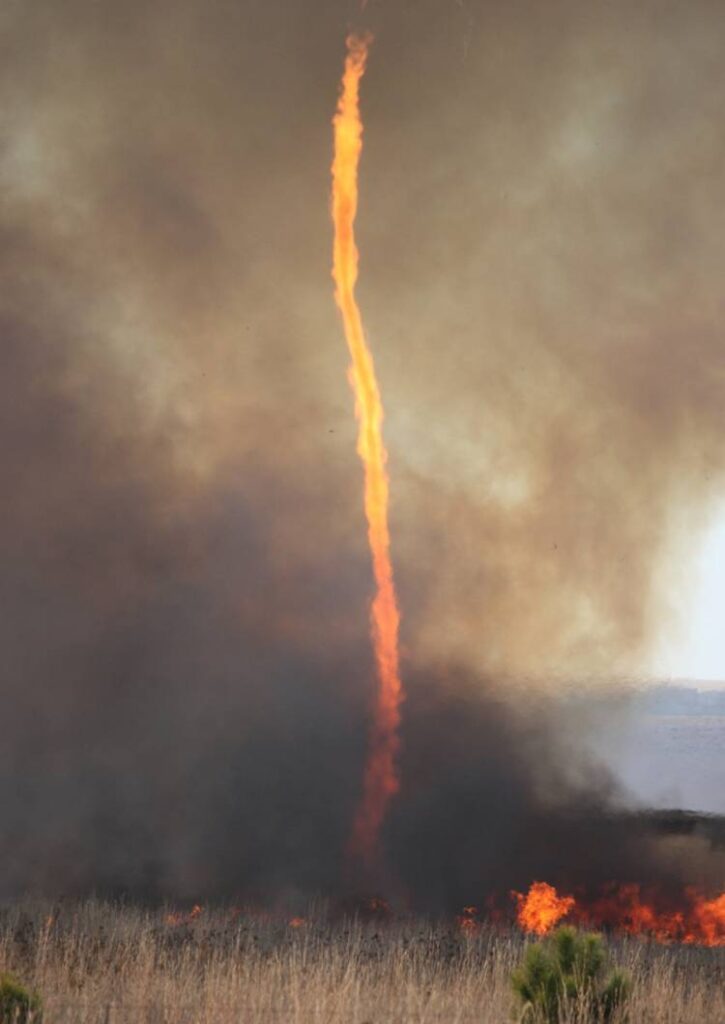Physical Address
23,24,25 & 26, 2nd Floor, Software Technology Park India, Opp: Garware Stadium,MIDC, Chikalthana, Aurangabad, Maharashtra – 431001 India
Physical Address
23,24,25 & 26, 2nd Floor, Software Technology Park India, Opp: Garware Stadium,MIDC, Chikalthana, Aurangabad, Maharashtra – 431001 India

Heavy rain at the site of The Burning Man festival held in Nevada annually had transformed the site into a muddy quagmire this year, compelling event organizers to close the sole access road to and from the festival. This festival draws a significant crowd of revellers who set up camp at the remote location. This year was no exception but the about 70,000-strong crowd had to endure unexpected weather conditions.
Social media and news platforms are flooded with images and videos of the mud and slush. There is, however, the video of a contrasting weather event going viral too. This video shows a fire tornado and is being shared with the claim that this is from Burning Man’s 2023 edition.
Here’s one such post:
We came across multiple posts with the same video. Some of the posts do not directly claim that the video is from this year’s Burning Man festival but have captions naming the same festival.
Here’s a Search Link from X where you can see the posts. Some of these posts have replies that say the video is actually from the main event in 2022. So we ran a Google search with relevant keywords to check if we found any such news.
The fact that the video is indeed from 2022 got confirmed when we came across news reports like this one by USA Today, published on their official YouTube channel on September 9, 2022.
What is a Fire Tornado?
Fire tornadoes are rare meteorological occurrences, sometimes known as “pyrogenetic tornadoes” due to their formation resembling that of traditional tornadoes, with a vortex of tornado strength. The terms “fire whirl,” “fire devil,” “firenado,” and “firestorm” are occasionally used interchangeably for fire tornadoes.
They can develop when intense upward heat and turbulent wind conditions intersect, giving rise to swirling air currents. These air currents can constrict into a vortex drawing in debris and flammable gases.

Even though it may be referred to as a fire tornado, it is not commonly categorized as a tornado because its vortex doesn’t consistently extend from the cloud base to the ground. Unlike typical tornadoes, fire whirls do not originate from a tornadic mesocyclone in the upper atmosphere but rather from temperature-induced lifting and surface winds. A mesocyclone, on the other hand, is an atmospheric vortex formed within a convective storm, where rising air circulates around a vertical axis in a manner similar to low-pressure systems in the specified hemisphere.
How dangerous are these Fire Swirls?
Composed of a burning core and a swirling air mass, these fiery vortexes can reach temperatures up to 1,090 °C. Fire whirls are generated when a wildfire, particularly a firestorm, generates its own wind, leading to the formation of sizable whirlwinds.
The majority of the largest fire tornadoes originate from wildfires. Typically, these whirls are between 10 to 50 meters in height and a few meters in width, and have a short lifespan of just a few minutes. However, some can reach heights exceeding 1 kilometre, with wind speeds surpassing 200 km/h (120 mph), and they can persist for more than 20 minutes.
Fire whirls possess the capacity to uproot trees that stand at least 15 meters tall. They also contribute to the “spotting” ability of wildfires, as they carry burning materials, such as tree bark, away from the primary fire area. These burning embers can be transported by stronger winds at higher altitudes. Such whirls are frequently observed in the vicinity of a volcanic plume during volcanic eruptions.
Is climate change leading to more frequent fire tornadoes?
Climate change is extending the duration and intensifying the wildfire seasons, and when these fires reach significant proportions, they can generate their own extreme weather phenomena. Among these phenomena are these fire tornadoes which were extremely rare earlier.
Many countries have witnessed an unprecedented rise in the number of wildfire incidents in recent years. According to a National Geographic article, hot and dry conditions during heatwaves help fires spread at a faster rate and also burn longer and with more intensity. Warmer air temperatures dry the forests and other vegetation by soaking up water. Intense record-breaking heat waves can cause major crisping of burnable material that can ignite easily. When ignition happens, even if the reason is natural, the chances of it turning into a big fire are much higher now with climate change.
What is the Burning Man Festival?
Burning Man is an annual, week-long convergence of art, community, self-expression, and self-reliance, taking place in the expansive Black Rock Desert within Pershing County, Nevada. This unique event unfolds on the playa of what was once Lake Lahontan, a body of water that dried up due to climate shifts during the Pleistocene era.
Drawing in a diverse and enthusiastic crowd numbering in the tens of thousands, Burning Man attracts an array of individuals, including artists, musicians, and activists. This gathering is characterized by a commitment to self-sufficiency, with most participants responsible for bringing their own provisions, such as food, water, and supplies. This approach lends an adventurous quality akin to wilderness camping, coupled with captivating artistic performances.
One of the distinctive highlights of Burning Man is the ceremonial burning of a colossal wooden effigy known simply as “the Man.” Revellers affectionately referred to as “Burners,” come together to construct a vibrant and ephemeral city called Black Rock City.
References:
https://agupubs.onlinelibrary.wiley.com/doi/full/10.1029/2019GL083699